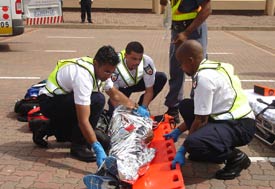Taking trauma care and injury prevention to the next level
May / June 2011 | Volume 10, Issue 3

Photo courtesy of WHO/Margie Peden
Traffic and weapons-related injuries are becoming the
leading global health threat to children and young adults
- mainly in developing countries.
By Steve Goldstein
The world is, in a word, traumatized. Injuries, mainly from motor vehicles and weapons, are rapidly becoming the number one global health threat to children, young adults and developing nations. More than 830,000 children die each year from road crashes, drowning, burns, falls and poisoning. In any given year, about one out of every three people will be injured severely enough to seek medical care. Injuries affect people from all walks of life but are very disproportionately experienced by the poor, creating one of the greatest sources of global health inequity.
Injuries are the largest contributor to disability in low- and middle-income countries (LMICs). People who die from injuries are, on average, more than 30 years younger than people who die from other leading causes. Injury is the leading cause of death from one to 44 years of age and the third leading cause of death overall in LMICs.
WHO reports that more than 90 percent of the world's injury deaths occur in LMICs and injury deaths per capita are three times higher in low- as opposed to high-income countries.
War fills newspaper headlines, but for every death due to war, there are three deaths due to homicide and five due to suicide, according to WHO. Worldwide homicides totaled nearly 500,000 in 2004, while one million suicides are reported annually.
Road accidents are the ninth leading cause of death in the world and rank as the top cause of death for people ages 15 to 29. About 1.3 million people are killed annually and between 20 and 50 million people experience non-life threatening traffic-related injuries - mostly in developing countries. Road traffic deaths are predicted to increase by 83 percent in LMICs by 2020.
Yet these injuries are highly unappreciated as a global health threat. "There's a sense of fatalism among people that injuries are accidents and bad luck, after all, and what can be done to prevent them?," explained trauma expert Dr. Charles Mock.
Because injuries so heavily affect individuals in their most productive years, the economic impact is substantial and further disadvantages LMICs. Yet injury is a highly preventable health threat. Injury prevention programs have been aptly equated with vaccines in terms of the protection they offer.
Fogarty's International Collaborative Trauma and Injury Research Training Program awards grants to conduct research training on the diagnosis, prevention and/or treatment related to injury and trauma in LMICs. It's the only program at NIH that provides support for trauma research and training in a global setting.
"The most important thing is to demonstrate that injury control works," said Dr. Mark Rosenberg, who helped found CDC's National Center for Injury Prevention and Control. "This is what can cause a paradigm shift."
Trauma and injuries are the number one cause of death among U.S. citizens abroad every year. There's a major need to improve trauma care and prevention in developing countries, which will reduce morbidity and mortality for Americans as well as others. U.S. universities collaborate with those in LMICs to enhance capacity in trauma prevention and care research with support from other Institutes and Centers at NIH.
"Trauma diminishes our quality of life," said UCLA's Dr. Gail Wyatt, a Fogarty grantee who has a trauma research program in South Africa. But the tide may be changing as research programs show gains.
"There is better understanding that injury is preventable and treatable and you can rehabilitate injured people to become productive citizens again," said grantee Dr. Beth Ebel, who leads a program in Ghana. "I hope this will lead to improved resources."
More Information
To view Adobe PDF files,
download current, free accessible plug-ins from Adobe's website.